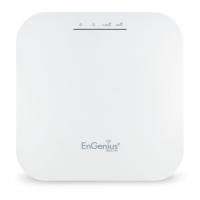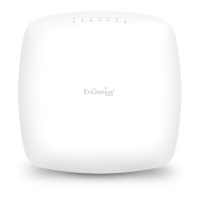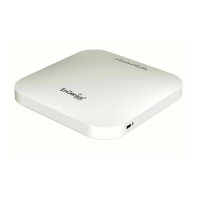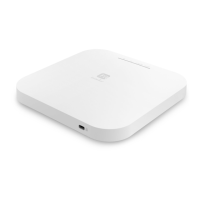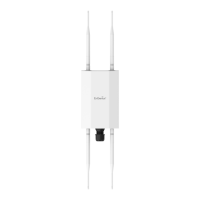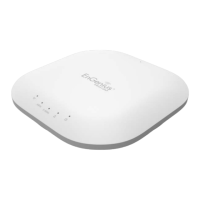Do you have a question about the EnGenius EWS330AP and is the answer not in the manual?
Details the core functionalities and technological advantages of the EWS330AP Access Point.
Lists the minimum system requirements for configuring the Access Point device.
Provides detailed technical specifications, including radio, interface, dimensions, and environmental parameters.
Illustrates and describes the physical ports, indicators, and mounting features of the EWS330AP.
Guides users on configuring their Windows or Mac OS computer network settings for the Access Point.
Provides step-by-step instructions for physically connecting the Access Point and its components.
Details the procedures for attaching the Access Point to a ceiling or a wall using provided hardware.
Specifies the default IP address, username, and password for accessing the Access Point's configuration.
Guides users through accessing and navigating the web-based interface for device configuration.
Describes the functionality of the EWS330AP when operating as a central connection for wireless clients.
Explains how the EWS330AP functions as a connection hub in a mesh network configuration.
Explains how to view and interpret the current operating status and system information of the Access Point.
Details the Local Area Network settings, including IP address, subnet mask, and DNS.
Provides details on wireless network configurations, SSIDs, and security settings for both 2.4GHz and 5GHz bands.
Presents statistical data on MAC addresses, received, and transmitted packets for network analysis.
Lists connected clients for 2.4GHz/5GHz bands and displays WDS link status information.
Shows real-time CPU loading percentage, traffic, and connection information for the Access Point.
Allows modification of the device's IP settings for both IPv4 and IPv6 network configurations.
Configures Spanning Tree settings to prevent network loops in the LAN environment.
Configures basic wireless settings like Device Name and enables advanced features like Band Steering.
Enables steering of dual-band clients to optimize performance between 2.4GHz and 5GHz bands.
Manages wireless network settings, including operation mode, wireless mode, channel, and transmit power.
Configures security modes like WEP, WPA-PSK, and WPA2-PSK for wireless network protection.
Allows configuration of advanced wireless settings such as traffic shaping for quality of service.
Regulates packet flow to deliver improved Quality of Service by setting download and upload limits.
Enables seamless roaming for mobile clients between Access Points for uninterrupted services.
Allows creation of a separate guest network for visitors, managing IP settings and client isolation.
Determines the Received Signal Strength Index for managing client handover between Access Points.
Controls network access by allowing or denying clients based on their MAC addresses.
Configures advanced wireless parameters for both 2.4GHz and 5GHz bands, including data rate and transmit power.
Assigns VLAN tags to packets for network segmentation and management.
Configures Simple Network Management Protocol (SNMP) settings for device monitoring and management.
Enables and configures Command Line Interface (CLI), SSH, and HTTPS for device management.
Sets up email alerts for system events, providing notifications for critical occurrences.
Configures the internal clock of the Access Point, including date, time, and daylight saving settings.
Specifies a schedule for automatically rebooting the Access Point to ensure stable operation.
Creates schedules to enforce rules for wireless access, restricting usage by time and day.
Analyzes connection quality by performing ping tests to target IP addresses or domain names.
Traces the routing path to a target IP address or domain name on the network.
Implements speed tests to measure the throughput of a target device and assess wireless speed.
Controls the on/off status of Power, LAN, and WLAN LEDs for visual indication of device status.
Discovers network devices and retrieves their operation mode, IP address, MAC address, and firmware version.
Allows changing the administrator username and password for accessing the Access Point.
Provides instructions for upgrading the Access Point's firmware to the latest version.
Saves current configurations, restores previous settings, or resets the AP to factory default settings.
Allows backing up user settings as default or restoring user settings to factory standards.
Records and displays events of interest in the Access Point's internal memory for monitoring and troubleshooting.
Sets up remote logging functions by specifying the IP address of the log server.
Exits the current management session by logging out from the Access Point's interface.
Reboots the device or restores it to factory or user default settings.
Provides the FCC statement regarding interference limits and compliance for Class B digital devices.
Details Industry Canada's statement on device compliance with RSS-247 and potential interference considerations.
Addresses IC radiation exposure limits for mobile devices, specifying installation and operating distance requirements.
Outlines the CE declaration of conformity for the device, complying with European Community directives.
Details the core functionalities and technological advantages of the EWS330AP Access Point.
Lists the minimum system requirements for configuring the Access Point device.
Provides detailed technical specifications, including radio, interface, dimensions, and environmental parameters.
Illustrates and describes the physical ports, indicators, and mounting features of the EWS330AP.
Guides users on configuring their Windows or Mac OS computer network settings for the Access Point.
Provides step-by-step instructions for physically connecting the Access Point and its components.
Details the procedures for attaching the Access Point to a ceiling or a wall using provided hardware.
Specifies the default IP address, username, and password for accessing the Access Point's configuration.
Guides users through accessing and navigating the web-based interface for device configuration.
Describes the functionality of the EWS330AP when operating as a central connection for wireless clients.
Explains how the EWS330AP functions as a connection hub in a mesh network configuration.
Explains how to view and interpret the current operating status and system information of the Access Point.
Details the Local Area Network settings, including IP address, subnet mask, and DNS.
Provides details on wireless network configurations, SSIDs, and security settings for both 2.4GHz and 5GHz bands.
Presents statistical data on MAC addresses, received, and transmitted packets for network analysis.
Lists connected clients for 2.4GHz/5GHz bands and displays WDS link status information.
Shows real-time CPU loading percentage, traffic, and connection information for the Access Point.
Allows modification of the device's IP settings for both IPv4 and IPv6 network configurations.
Configures Spanning Tree settings to prevent network loops in the LAN environment.
Configures basic wireless settings like Device Name and enables advanced features like Band Steering.
Enables steering of dual-band clients to optimize performance between 2.4GHz and 5GHz bands.
Manages wireless network settings, including operation mode, wireless mode, channel, and transmit power.
Configures security modes like WEP, WPA-PSK, and WPA2-PSK for wireless network protection.
Allows configuration of advanced wireless settings such as traffic shaping for quality of service.
Regulates packet flow to deliver improved Quality of Service by setting download and upload limits.
Enables seamless roaming for mobile clients between Access Points for uninterrupted services.
Allows creation of a separate guest network for visitors, managing IP settings and client isolation.
Determines the Received Signal Strength Index for managing client handover between Access Points.
Controls network access by allowing or denying clients based on their MAC addresses.
Configures advanced wireless parameters for both 2.4GHz and 5GHz bands, including data rate and transmit power.
Assigns VLAN tags to packets for network segmentation and management.
Configures Simple Network Management Protocol (SNMP) settings for device monitoring and management.
Enables and configures Command Line Interface (CLI), SSH, and HTTPS for device management.
Sets up email alerts for system events, providing notifications for critical occurrences.
Configures the internal clock of the Access Point, including date, time, and daylight saving settings.
Specifies a schedule for automatically rebooting the Access Point to ensure stable operation.
Creates schedules to enforce rules for wireless access, restricting usage by time and day.
Analyzes connection quality by performing ping tests to target IP addresses or domain names.
Traces the routing path to a target IP address or domain name on the network.
Implements speed tests to measure the throughput of a target device and assess wireless speed.
Controls the on/off status of Power, LAN, and WLAN LEDs for visual indication of device status.
Discovers network devices and retrieves their operation mode, IP address, MAC address, and firmware version.
Allows changing the administrator username and password for accessing the Access Point.
Provides instructions for upgrading the Access Point's firmware to the latest version.
Saves current configurations, restores previous settings, or resets the AP to factory default settings.
Allows backing up user settings as default or restoring user settings to factory standards.
Records and displays events of interest in the Access Point's internal memory for monitoring and troubleshooting.
Sets up remote logging functions by specifying the IP address of the log server.
Exits the current management session by logging out from the Access Point's interface.
Reboots the device or restores it to factory or user default settings.
Provides the FCC statement regarding interference limits and compliance for Class B digital devices.
Details Industry Canada's statement on device compliance with RSS-247 and potential interference considerations.
Addresses IC radiation exposure limits for mobile devices, specifying installation and operating distance requirements.
Outlines the CE declaration of conformity for the device, complying with European Community directives.
| Internal | No |
|---|---|
| Placement | Ceiling |
| Reset button | Yes |
| Product color | White |
| LED indicators | System, WLAN |
| Bandwidth | 5 GHz |
| MIMO type | Multi User MIMO |
| Modulation | 16-QAM, 64-QAM, 256-QAM, BPSK, CCK, QPSK |
| Fit AP mode features | Mesh networking |
| Networking standards | IEEE 802.11a, IEEE 802.11ac, IEEE 802.11b, IEEE 802.11k, IEEE 802.11n, IEEE 802.11r |
| Virtual LAN features | Tagged VLAN, SSID-based VLAN assignment |
| Ethernet LAN data rates | 10, 100, 1000 Mbit/s |
| Maximum data transfer rate | 1267 Mbit/s |
| Maximum data transfer rate (5 GHz) | 867 Mbit/s |
| Maximum data transfer rate (2.4 GHz) | 400 Mbit/s |
| USB 2.0 ports quantity | - |
| Ethernet LAN (RJ-45) ports | 1 |
| Storage temperature (T-T) | -40 - 80 °C |
| Operating temperature (T-T) | 0 - 40 °C |
| Operating relative humidity (H-H) | 0 - 90 % |
| Input current | 1 A |
| AC input voltage | 12 V |
| Security algorithms | 64-bit WEP, 128-bit WEP, 152-bit WEP, WPA, WPA-AES, WPA-EAP, WPA-TKIP, WPA2-Enterprise |
| Harmonized System (HS) code | 85176990 |
| Width | 132.4 mm |
|---|---|
| Height | 22.4 mm |
